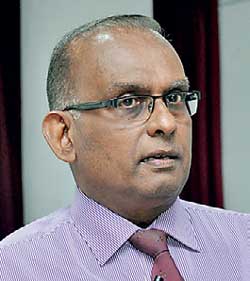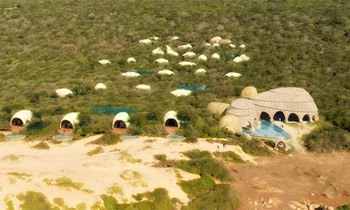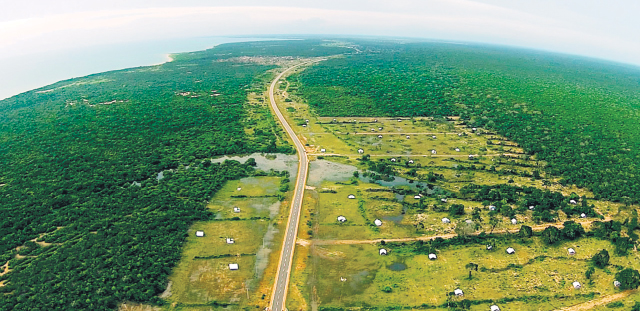
Tourism stakeholder proposes ‘colourful stories’ to sell wildlife to tourists
Stakeho lders engaged in marketing Sri Lanka tourism should be creating colourful stories of the wildlife experiences in Sri Lanka instead of presenting basic facts in order to better promote tourism, an industry veteran stressed recently. “There is no promotion or communication, not necessarily by the Sri Lanka Tourism Promotions Bureau, but by private companies too. We need to create unusual stories,” an ex-President of The Hotels Association of Sri Lanka (THASL), Srilal Miththapala said, at an event organized at the Ceylon Chamber of Commerce recently. Miththapala, a well-known wildlife enthusiast, said that when a potential tourist calls a hotel or a travel agency to inquire about the wildlife attractions in Sri Lanka, the employees usually list the animals that could be observed, instead of portraying wildlife in an attractive manner. “They don’t need to know that the animals are there. Anyone can find that out. They need to hear the stories,” he said. This wo
lders engaged in marketing Sri Lanka tourism should be creating colourful stories of the wildlife experiences in Sri Lanka instead of presenting basic facts in order to better promote tourism, an industry veteran stressed recently. “There is no promotion or communication, not necessarily by the Sri Lanka Tourism Promotions Bureau, but by private companies too. We need to create unusual stories,” an ex-President of The Hotels Association of Sri Lanka (THASL), Srilal Miththapala said, at an event organized at the Ceylon Chamber of Commerce recently. Miththapala, a well-known wildlife enthusiast, said that when a potential tourist calls a hotel or a travel agency to inquire about the wildlife attractions in Sri Lanka, the employees usually list the animals that could be observed, instead of portraying wildlife in an attractive manner. “They don’t need to know that the animals are there. Anyone can find that out. They need to hear the stories,” he said. This wo
uld require private sector tourism professionals to have high levels of wild life experience and enthusiasm, which Miththapala said that he is trying to cultivate by conducting educational sessions in schools across the island. While a number of high-powered private sector individuals were in attendance, Miththapala advised them that the message has to go down to their employees who communicate with tourists. Miththapala presented dozens of stories on his encounters with various animals in Sri Lanka and especially the elephants in Pinnawela and the Elephant Transit Home in Udawalawe, in addition to the humorous, dangerous and often illegal practices he has observed park guides and drivers undertake in order to please their clients. However, he stressed that the tourism industry has to act as a guardian of the wildlife attractions in Sri Lanka instead of causing their degradation, which the private sector has to be vigilant about. “It’s the hotels and the tour operators that give 90 percent of the business to these drivers. So you could maybe blacklist these drivers,” he suggested, and noted that Sri Lanka Association of Inbound Tour Operators has now banned elephant rides, which is a welcome development that hotels should also follow. Meanwhile, Miththapala added that hotels should encourage their naturalists engage in creating stories for tourists to enjoy. Jetwing Vil Uyana engages in this practice, with posters and logbooks recording encounters visitors have with wildlife in the area. He said that with a country which has 30 percent of green cover, over 3,000 plants and over 1,000 animal species including the ‘Big Four’ mammals; the blue whale, elephant, leopard and the sloth bear, Sri Lanka should have no shortage of tourism promotional material. In contradiction, Sri Lanka’s tourism promotional efforts have received criticism over the past several years. Miththapala alluded to the possibility that if Sri Lanka is able to attract the types of tourists who would value and pay for sustainable products, the government does not have to pursue its current numbers oriented strategy. “I wonder whether Sri Lanka really needs these types of numbers, whether we can look at a different strategy,” he said. Sri Lanka welcomes 2.05 million tourists in 2016, raising US$ 3.5 billion in revenue. An official document released recently by the Sri Lanka Tourism Development Authority placed the government’s target for 2020 at 4 million tourists. In 2015, when 1.8 million tourists visited the island, 19 of the 26 identified national parks had sold 558,521 foreign visitor tickets, raising Rs. 1.01 billion. Miththapala said that there is greater potential to derive income from national parks, but that the government and the private sector have to work together to divert tourists from the overburdened parks such as Yala into lesser known parks, where creating stories could play a great role in achieving this objective. (CW)
Source-25/01/2017,Daily Mirror/See more at: http://www.dailymirror.lk/article/Tourism-stakeholder-proposes-colourful-stories-to-sell-wildlife-to-tourists-122694.html#sthash.TFpwR9XV.dpuf

Energy regulator wants CEB to fast-track connecting domestic solar panels to national grid
The electricity sector regulator, the Public Utilities Commission of Sri Lanka (PUCSL), yesterday directed the Ceylon Electricity Board (CEB) and Lanka Electricity Company Private Limited (LECO) to connect the domestic rooftop solar panels to the national grid within two weeks from the date of application. “The direction to provide the connection for rooftop solar plants to the national grid in an efficient manner within a time fame will encourage people to move for solar power,” PUCSL Director General Damitha Kumarasinghe said.The PUCSL has asked the CEB and LECO to provide an estimate for the net metering installation within one week of submission and payment of the application and to provide the net meter installation and grid connection within a week of receiving the payment for the net meter installation. Kumarasinghe said that among Sri Lanka’s non-conventional renewable energy sources, rooftop solar PV is considered as one of the fastest technologies that can be installed and integrated into the grid. The PUCSL said that the aim is to add 200 MW of solar electricity to the national grid by 2020 and 1,000 MW by the year 2025. “So far Sri Lanka has added about 42 MW of capacity to the national grid through domestic rooftop solar plants by the end of 2016,” Kumarasinghe added. Data further reveals that up to November 2016, 7,904 domestic rooftop solar plants had been installed and connected to the national grid. The PUCSL said that 1,420 domestic rooftop solar plants were added through the government’s ‘Soorya Bala Sangramaya’ programme, which was launched last year. Of the total, 4,806 are in the Western Province and 1,707 are in the Northern Province. Uva, the country’s most impoverished province, had just 32 rooftop solar plants installed. The PUCSL said that the government policy is to increase the existing 50 percent of the electricity generation based on renewable energy sources to 60 percent by the year 2020 and to increase it further up to 70 percent by the year 2030. It added that the government’s aim is to generate the country’s total energy requirement through renewable and other indigenous energy resources by 2050. The country had faced major disruptions to power last year and there are concerns of a power crisis arising over the next two years, which has seen the PUCSL spurring the CEB to enact contingency measures. See more
Source – 26/01/2017, Daily Mirror, See more at: http://www.dailymirror.lk/article/Energy-regulator-wants-CEB-to-fast-track-connecting-domestic-solar-panels-to-national-grid–122738.html#sthash.5z5Cbq3P.dpuf

Additional 155 perches for Palatupana luxury camps
The government has decided to provide an additional land of 155 perches, apart from the previously given 7 acres, to the Wild Coast Lodge (PVT) Ltd to construct luxury tourist camps adjacent to the Yala National Park. Earlier, a land of 7 acres belonged to the Sri Lanka Tourism Development Authority in Palatupana area had been allocated to the company for this purpose. Tourism Development and Christian Religious Affairs Minister John Amaratunge has proposed to provide the additional block of land on a 50 year lease basis to continue the project. The Minister has also sought the approval of the Coast Conservation Department, Coastal Resources Management and the recommendations of Wildlife Conservation Department in continuing with construction works of the project. See more
Source- 25/01/2017Daily Mirror, See more at: http://www.dailymirror.lk/article/Additional-perches-for-Palatupana-luxury-camps-122732.html#sthash.ZHrHBfae.dpuf

Environmentalists threaten legal action over N P deforestation
Environmentalists threatened to take legal action against the Government if it failed to take measures to control and halt the continuing destruction of forests in the Northern and Eastern Provinces for purposes of resettlement, new settlements, encroachment and timber rackets.
Environmentalists, the Presidential Secretariat personnel, officials of the Department of Forest Conservation and the Department of Wildlife Conservation are conducting discussions in this regard at present.
The Environment Conservation Trust explained that thus far 3,400 acres of forest cover had been cleared and new settlements erected in Wilpattu, in the forest reserves in Wilpattu North including in the zones of Maraichukkaddi/Karadikkuli, Vilathikulam and Mawillu.
Other forest reserves include Karunkalipuram, Puwarasankulam, Kulamarippu, Nagancholai, Irasenthiramkulam, the Madu Road. He said 17,800 acres have been cleared illegally to make way for new settlements in Mannar, Mullaitivu and Vavuniya where post-war, which were and are spreading.
Director of the Trust, Sajeeva Chamikara pointed out that in the case of forest clearance in Wilpattu, though the amount of human settlements and occupations were less, three times the land cleared for human settlements had been cleared including for purposes of land grabbing and timber racketeering.
Meanwhile, President Maithripala Sirisena’s directive to expand the borders of the Wilpattu National Park has yet to be implemented in the declared areas including the sanctuaries and zones.By RLJ
Source :21/01/2017 The Nation/See more at:http://nation.lk/online/2017/01/21/environmentalists-threaten-legal-action-over-n-p-deforestation.html






